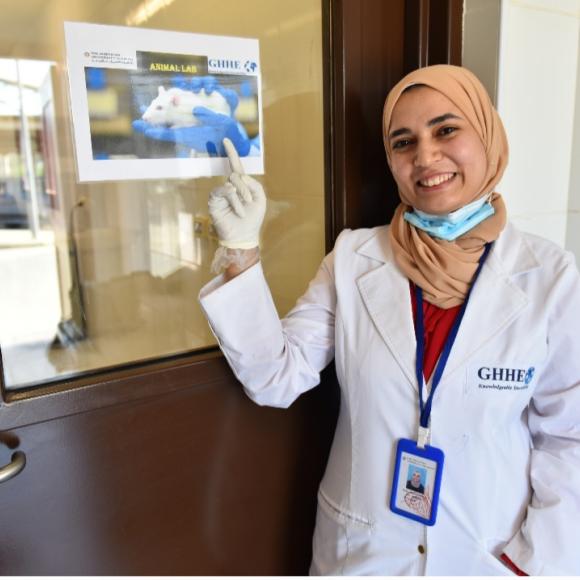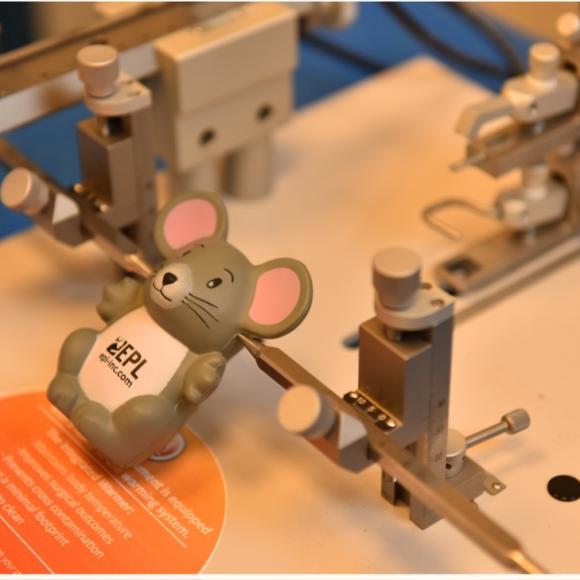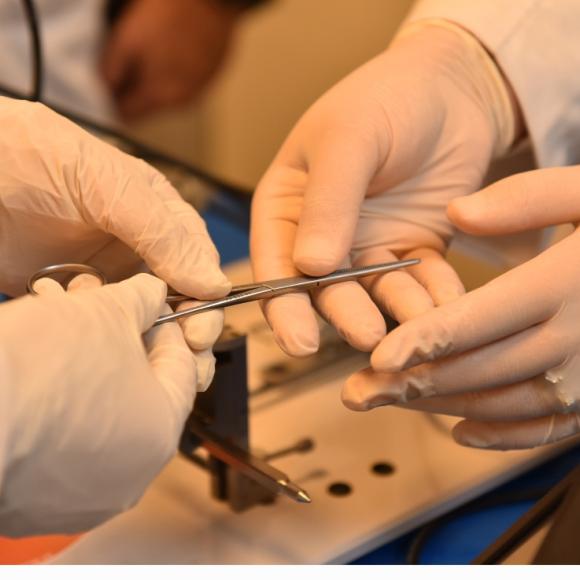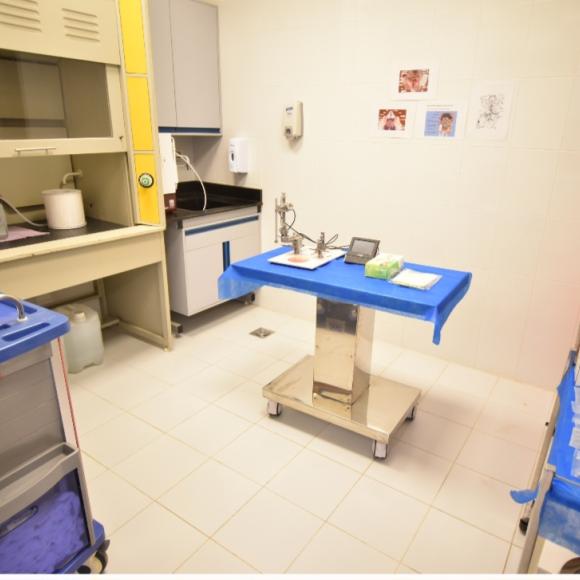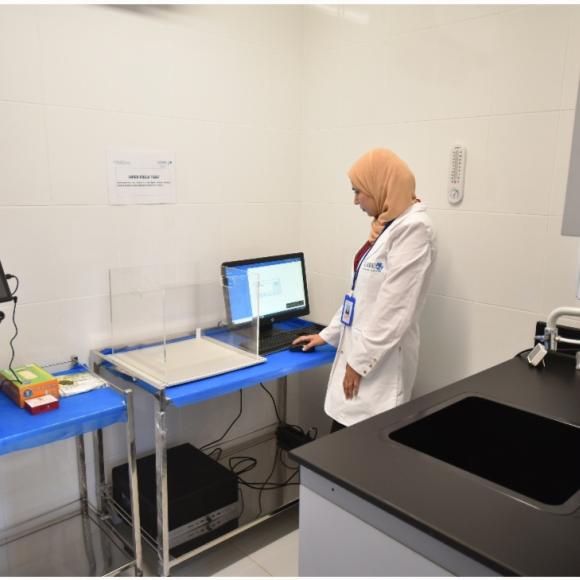The Facility and Capabilities
- Research at AUC
- Institutional Animal Care and Use Committee (IACUC)
- The Facility and Capabilities
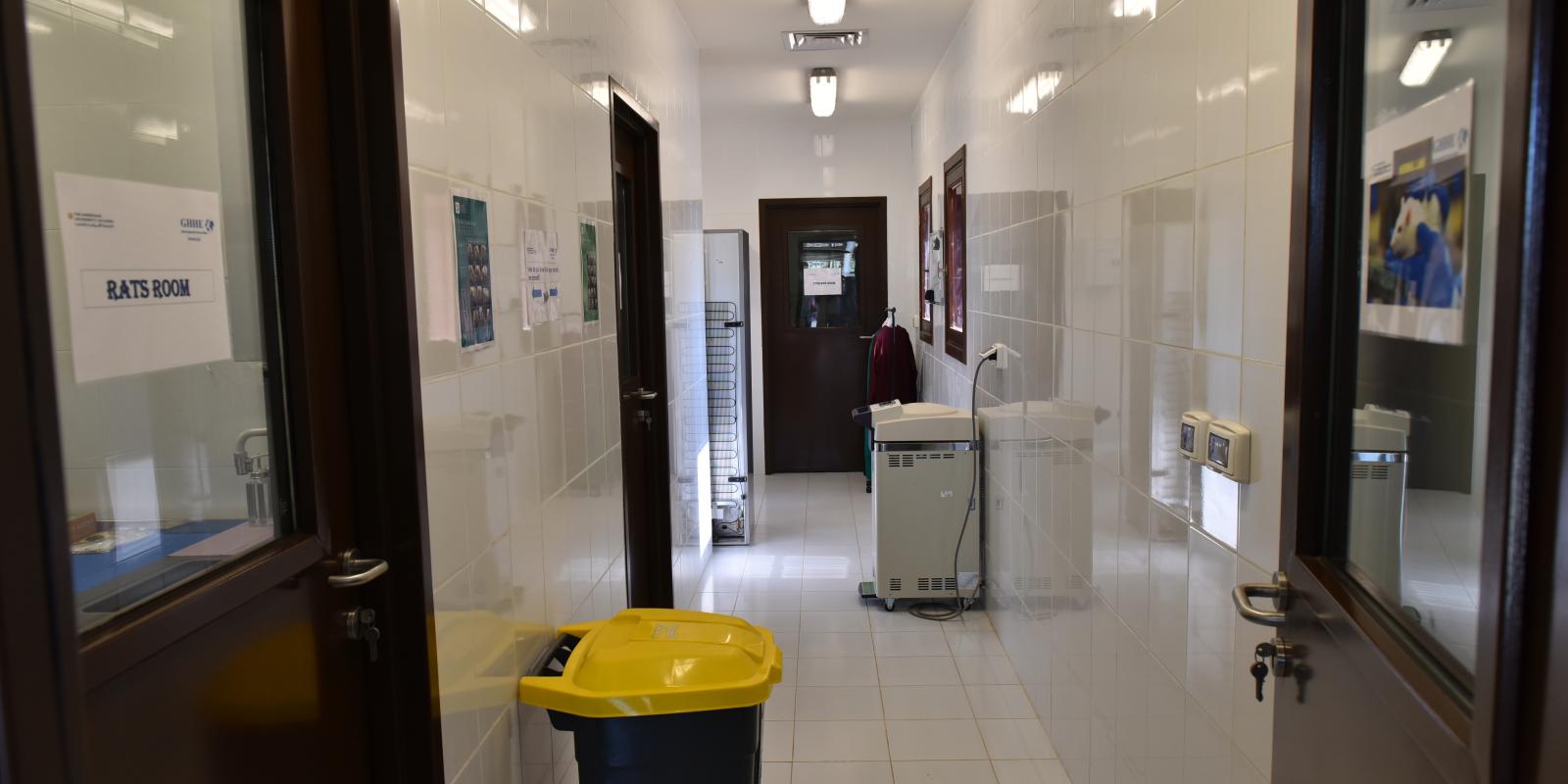
Vivarium Regulations
The use of and access to the animal facilities at The American University in Cairo are restricted to authorized University personnel and their students participating in collaborative research efforts, scientific peer review or teaching activities. Unauthorized entry poses a security threat, may alter experimental outcomes, can jeopardize animal health and can unnecessarily expose personnel to infectious, chemical, or other hazards.
Authorized personnel must have completed the specified CITI training and Vivarium orientation, as well as being named on an IACUC approved protocol. Upon completion of required training, individuals must work with the Animal Care Specialist, providing contact information of the direct researcher and the faculty with whom they work. For activities outside working hours or days, it is essential that the investigator(s) arrange access with the Animal Care Specialist.
Unauthorized persons who desire entry for animal research reasons (e.g., to observe experimental procedures) require prior approval from the Animal Care Specialist. An authorized member of the investigator's staff must accompany all visitors. Because of the concern for human and animal health, children and pets are not allowed in the Vivarium.
Criteria for Entry into Animal Rooms
- Training
- Isolation gown, gloves, mask, head cover and shoe covers
- Compliance to continue use
Absolutely no food or drink in the vivarium. A second violation is grounds for loss of present and future access.
The AUC staff have identified a reliable source of mice and rats. Animals arriving from facilities other than those sources may not meet the health standards that this facility sets. For this reason, animals must be obtained from approved sources. Investigators are asked to verify that the animals required cannot be obtained from an approved source before submitting a request to obtain them from a non-routine vendor.
Rodents acquired from other universities or institutions may not have as comprehensive health histories and pathogen testing as performed by our approved vendors. Such rodents pose a potential threat to other animals in the vivarium. Health information about animals requested from non-routine sources will be evaluated by the veterinarian.
Like all new additions to the facility, non-routine source animals that are destined for chronic housing at AUC must undergo a quarantine period before coming in contact with other animals in the facility. Screening tests will be performed, at the investigator’s expense, before the animals may be housed with resident populations.
Animals requested for acute use may be accepted at this facility within quarantine for a fixed amount of time, not to exceed two weeks. Their manipulation/sacrifice must be done in a way that will not threaten the health of resident animal populations. The Animal Care Specialist and veterinarians will work with investigators to determine if/how animals requested for acute use can be safely acquired and utilized. Under no circumstances are animals intentionally exposed to infectious agents allowed!
For genetically-manipulated animals (transgenic and knockout strains) or immunosuppressed strains, arrangements must be made in advance, so their housing is not in the general population.
Attending to your Animals
It is the responsibility of the investigator(s) to distribute their protocol approved animals to their housing. While the Animal Care Specialist will assist in this process, it is essential that the take responsibility to preserve the integrity of their research. As such, solution preparation, dosing, procedures, discarding of bio- and chemical hazards, euthanasia and necropsy are the responsibility of the investigator(s). As a trained veterinarian, the Animal Care Specialist will assist and advise, but is not responsible for executing an investigator’s protocol. Whether or not the protocol requires daily or weekly monitoring for distress and pain, that is the responsibility of the investigator(s). The Animal Care Specialist will take on the responsibility of routine monitoring and alert the investigator(s) of any unforeseen event, or noncompliance.
Cage Density
While group housing, depending on the protocol, is recognized as providing enrichment, overcrowded cages represent a significant animal welfare concern, as they can induce distress. For the savvy researcher evaluating behavior, pharmaceutical or toxicological evaluation, this will influence the outcome. Furthermore, such cages are noncompliant with Public Health Service (PHS) Policy and our assurance to PHS. The Guide for the Care and Use of Laboratory Animals states the PHS recommendations for housing densities.
1. Mouse Cage Density Policy
Overcrowded mouse cages represent a significant animal welfare concern. Such cages are noncompliant with Public Health Service (PHS) Policy and our assurance to PHS. The Guide for the Care and Use of Laboratory Animals states the PHS recommendations for housing densities. This is standardized for static cages (shoebox) accommodate four mice greater than 28 days of age. Cage densities exceeding these numbers represent clear policy violation.
Standard shoebox cages are 67 sq. in and can house four same sex mice or a breeding pair with litter.
2. Rat Cage Density Policy
Per the Guide for the Care and Use of Laboratory Animals states the PHS recommendations for housing densities. In order to standardize housing densities and prevent or eliminate the possibility of overcrowding within cages, this is standardized for the number of rats per cage depending on the weight of the rat(s) and the size of the cage.
Rats weighing in excess of 500 grams can be pair housed in large plastic shoebox cages 12.25 X 21.75 X 8, 266.4 sq. inches
Breeding pairs may be setup but the male will need to be removed prior to the female giving birth. A female with litter requires 124 sq. in. of floor space.
Same sex rats will be housed according to the chart below. Note, that males housed at high density will exhibit aggressive behavior.
Required Floor Space Per Rat
A standard rat cage has 143 square inches floor space.
<100 g per rat = 17 sq. inches/rat = 8 rats
Up to 200g per rat = 23 sq. inches/rat = 6 rats
Up to 300g per rat = 29 sq. inches/rat = 4 rats
Up to 400g per rat = 40 sq. inches/rat = 3 rats
Up to 500g per rat = 60 sq. inches/rat = 2 rats
> 500g per rat = >70 sq. inches = 1 rat
Female w/ litter = 124 sq. inches
Cage densities exceeding these numbers represent clear policy violation.
It is the responsibility of investigators, whether faculty, students or staff, to ensure that housing and procedure rooms, including counters, biohazards (animals, tissue, blood splatter), instruments and perishable supplies be removed and disposed of properly. Animal carcasses, tissue, sharps, and used supplies must be bagged and stored in the appropriately marked refrigerator or freezer for disposal by vivarium staff. Due to health concerns and professionalism towards other investigators, it is the users’ responsibility and not the function of the vivarium staff, who will assist and inspect to ensure that the facility is ready for the next procedure.
While the vivarium provides essential equipment, representative surgical tools, anesthetics and euthanizing agents, it is the responsibility of investigator to provide supplies exclusive to their protocol, such as venipuncture vials, tissue collection receptacles, histology cassettes, surgical saline and buffers, diverse agents, pharmaceutical and other chemicals, that they may require to carry out the protocol.
The vivarium is responsible for the routine cleaning, maintenance, feeding and watering of the animals and housing. Unless, specifically called for by an approved protocol (e.g., dosing in the water), this is carried out by the Animal Care Specialist. As is customary, cost of bedding and animal chow will vary from one study to another. However, it should be noted that as an academic entity, investigators are not charged at cost, but are subsidized, this reducing their actual rate. The current per diem (i.e., cost/animal) for your protocol is calculated as follows:
LE 4/ea/d
For a study using 30 animals for 30 days:
5 x 30 = LE 150/animal/duration x 30 animals = 4,500 Study Grand Total LE
Regulation and policy mandate the maximum duration of time that research animals can be kept outside of the housing facility. Animals regulated by the United States Department of Agriculture (USDA), which includes rodents are not permitted to be away from their housing rooms for more than 12 hours at a time. Public Health Service (PHS) Policy prohibits these animals from being out of the vivarium for longer than 24 hours.
As the AUC facility is designed for one-way workflow, animals that leave the facility cannot be returned to general housing or the facility. The ONE AND ONLY exception is animals undergoing live-testing in the procedure room and returned to their housing for future follow-up.
- Make sure that the doors to laboratories and procedure rooms in which animals are present are closed.
- Never leave animals in restraint devices or unconscious animals unattended.
- Rodents left unattended in laboratories must be secured behind locked doors.
- Live animals that leave the facility must be maintained in the laboratory in appropriate enclosures (clean, uncrowded, safe, secure, with sufficient food and water) as described in the approved protocol.
- Investigators, including students’ advisors, are ultimately responsible for the safety and security of animals present in their laboratories.
Because of public health, animal health, security, and public relations considerations, the AUC Vivarium policy mandates that laboratory animals be transported in a specified manner. They are required to be moved in either their primary enclosures or in approved transport cages that are escape-proof, adequate in size, and made of materials that can be readily sanitized. All cages or other transport devices must have solid bottoms or be placed in a secondary container so as to contain animal waste. All devices must be appropriately sanitized between use.
All devices used to transport animals out of the Vivarium proper must be either enclosed in a second container or covered with a drape or other material so the animal(s) are not visible.
Public elevators must not be used to transport laboratory animals. Only specified passenger and freight elevators may be used for this purpose. Under no circumstances can laboratory animals be brought into or through public, non-science or classroom corridors.
An investigator, faculty, student, or staff member, loses their privilege of accessing the Vivarium:
- On completion of a study;
- Failure to comply with policies on housing, monitoring or transporting animals to and from the vivarium;
- Admitting unauthorized person or persons;
- Poses a risk to animal welfare. Including neglect. This will trigger and IACUC investigation;
- Poses a risk to themselves or others in failing to adhere to safety protocols in gowning, handling, euthanasia, or necropsy;
- Eating and drinking in the vivarium;
- Unauthorized interference with another investigator’s protocol;
- Unapproved deviation from the protocol;
- Sanction by the IACUC for violations.
The Facility
The Vivarium is a state-of-the-art rodent housing unit under the supervision to two staff veterinarians. It is established to facilitate ethical preclinical research.
Designed for one-way traffic flow, with a quarantine room for receiving animals (rats and mice), two rooms for housing rats (100 individual animal capacity in shoe-box cages), and one room for mice.
Depending on the density and species in-house, one of the rat rooms serves for overflow or sensitive protocols. All rooms have independent temperature, ventilation and day-night cycle control. In addition, a fully-equipped procedure room equipped for surgery, stereotaxic procedures, open-field behavioral assessment, and necropsy is available, as well as basic blood chemistry and hematology. For use of the facility and ethical research conduct, AUC subscribes to CITI-training and has an IACUC committee. Only IACUC approved protocols and investigators will be granted access.
Asset Description | Room | Capitalized on |
|
|
|
Supply Storage Refrigerator | Vivarium | March 16, 2022 |
Red bag Biohazard Disposal Refrigerator | Vivarium | March 16, 2022 |
Deep freezer | Vivarium | March 16, 2022 |
Digital balance for Animal Weights | Vivarium | April 19, 2022 |
Digital balance for Prep | Vivarium | April 4, 2022 |
Binocular microscope for hematology | Vivarium | March 24, 2022 |
Surgical Table | Vivarium | June 30, 2022 |
Rodent Nose-only Inhalation Exposure System | Vivarium | April 30, 3023 |
Peristaltic perfusion pump for whole animal perfusion | Vivarium | November 17, 2020 |
Autoclave for sterilizing surgical tools and bedding | Vivarium | May 23, 2022 |
Water purification system | Vivarium | March 24, 2022 |
Stoelting Digital new standard stereotaxic surgery unit | Vivarium | June 23, 2022 |
Stoelting Open field testing system | Vivarium | May 16, 2022 |
Small Animal Anesthesia Delivery System | Vivarium | May 16, 2022 |
Cages and Racks | Vivarium | 2022 |
